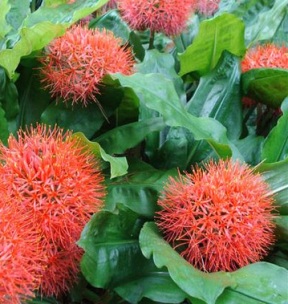At this time of the year, citrus trees are our biggest selling item by far. We have been fortunate over the last few years to be able to stock Flying Dragon and Flaming Dragon citrus. This refers to the type of Poncirus trifoliata root-stock that the plants are grafted onto, with Flaming being the regular sized trees and Flying the dwarf. Dwarf trees are really popular, especially for potted citrus plants or for those with a limited planting space. They grow up to half the size of the regular trees (if planted in the ground, less in pots,) but can produce almost the same amount of fruit. Amazing.
Here’s a list of what we still have in stock. Each tree is $17.50 except for Ponderosa Lemon and Limequats which are $20.00.
Lemon Trees
Meyer – Easy to grow, this medium-sized tree will reach approximately metres x 1.5 metres in around 3-4 years. Reliably produces a good crop of sweet, less acidic fruit.
Lisbon – Grows into a large tree. More acid in the fruit gives it a tartness that is fantastic for savoury cooking.
Yen Ben – A sport from the Lisbon, this is the main commercial variety that you can buy in New Zealand stores. Juicy, small fruit with good tartness. A smaller tree than the Lisbon.
Ponderosa – This is one BIG lemon and it grows on a large tree that can reach 5 or 6 metres when mature. A tangy and very juicy fruit perfect for anyone that uses a lot of lemon juice. Fruit can be left mature on the tree for months, handy for when other types are not producing. A spectacular looking tree often grown also as an ornamental.
Lime Trees
Tahiti Lime – Also known as Persian or Bearss Lime, this sweet, seedless lime is usually picked or purchased green, although it turns yellow as it reaches maturity. A perfect all-purpose variety.
Kaffir Lime – The leaves and the rind of this variety provides the aromatic, tart flavour found in dishes from South-east Asia, which is where it comes from. The juice is more acidic than that of the Tahiti Lime. One of our most popular plants.
Limequat – New to us this year, this cross between a key lime and a kumquat is perfect for those who make marmalade. Fruits copiously from a young age and remains a small tree. Very juicy, can be eaten whole or use as you would any lime.
Mandarin Trees
With 3 or 4 different varieties of Mandarins you can enjoy this fruit nearly all year round. We have stocked many different varieties over the years and have found the following to be the most popular.
Encore – Very sweet and juicy, easy to peel thin skin. Quick growing tree that produces plenty of fruit November to February.
Clementine Corsica – Always a favourite, clementines now have very few pips and are easier to peel. Lovely round fruit that starts ripening in July. Fruit not picked will stay ripe on the trees for months.
Burgess Scarlet – Produces beautiful tasting fruit, with loads of flavour. Ripens in September to October. Only available on dwarf stock.
Satsuma – Very popular, well-known Satsuma are large, sweet and easy to peel. Ripens from June to July.
Orange Trees
Blood Orange – Delicious medium-sized fruit that ripens July to August. Richly coloured juice with good flavour.
Seville Orange – Beautiful large tree with dark green foliage, this is a very bitter, old-variety orange used for marmalade.
Navelina – Good all-purpose eating orange. Nice size with good flavour. Ripens in June/July.
Grapefruit Trees
Cutlers Red – Rich red skin colour. Good taste and size. Ripens July to August.
Golden Special – Our most popular grapefruit, this produces lots of large, juicy fruit. Easy to peel and great for marmalade and juice.
Tangelo Seminole – Has a beautiful taste and very juicy fruit. Great for the kids. Ripens from August to October.
Uglifruit – Great to eat, these are currenly experiencing a resurgence in popularity. Large tree and large fruit, these have thick skins but are very easy to peel and their orange flesh has a lovely taste. Ripens September to October.
Filed under: Citrus, For Sale, New Zealand, Northland | Tagged: Blood Orange Trees, Burgess Scarlet, Citrus Trees, Clementine, Cutlers Red Grapefruit, Dwarf Citrus, Encore, Flaming Dragon, Flying Dragon, Golden Special Grapefruit, Kaffir Lime, Lemon Trees, Lemonade Trees, Limequat, Lisbon, Mandarin Trees, Meyer, Navelina Orange, Ponderosa, Satsuma, Seville Orange, Tahiti Lime, Tangelo, U, Uglifruit Trees, Yen Ben | 1 Comment »























